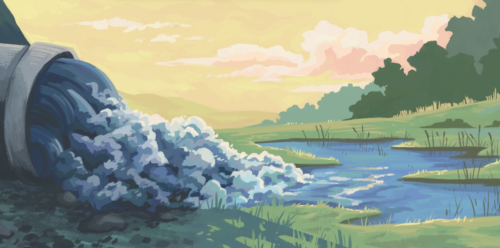
Illustration by Kelsey King
As climate change alters the movement of water on land and in the air, a call for Slow Water
August 4, 2022, This is an edited excerpt from Water Always Wins: Thriving in an Age of Drought and Deluge by Erica Gies, copyright © University of Chicago Press, 2022.
Learn more at slowwater.world.
Epic flooding has killed hundreds of people across Pakistan, India, South Africa, Germany, New York, Kentucky and British Columbia, Canada, in the last year. Intense droughts are parching landscapes and wilting crops across Texas, the U.S. West and the Horn of Africa. As these water extremes hit more and more people where they live, there’s a growing awareness that climate change is water change.
People usually respond to these disasters by calling for higher levees, bigger drains and longer aqueducts. But such interventions are increasingly failing. As we grapple with climate extremes, a hard truth is emerging:
Our development choices — urban sprawl, industrial agriculture and even the concrete infrastructure designed to control water — are actually exacerbating our problems and raising the stakes for failure.
Because sooner or later, water always wins.
The dominant culture views water as either a commodity or a threat, which is why we seek to control it. But the way we relate to water is not inevitable.
Today, “water detectives” — ghost-stream hunters, ecologists, biologists, landscape architects, urban planners, environmental engineers — around the world are instead working from a philosophy rooted in curiosity, respect and humility, rather than a too-common arrogance.
They start with a radical question: “What does water want?”
To find out, the detectives are uncovering what water did before generations of humans so radically transformed our landscape and waterways.
How did water interact with local rocks and soils, ecosystems and climates before we scrambled them? With their discoveries, we begin to understand why certain areas flood repeatedly, or how our tendency to speed water off the land deprives us of urgently needed local rainfall that — if allowed to move underground — could supply streams in summer.
Then we begin to think creatively about how we can solve these problems by making space for water within our human habitat.

